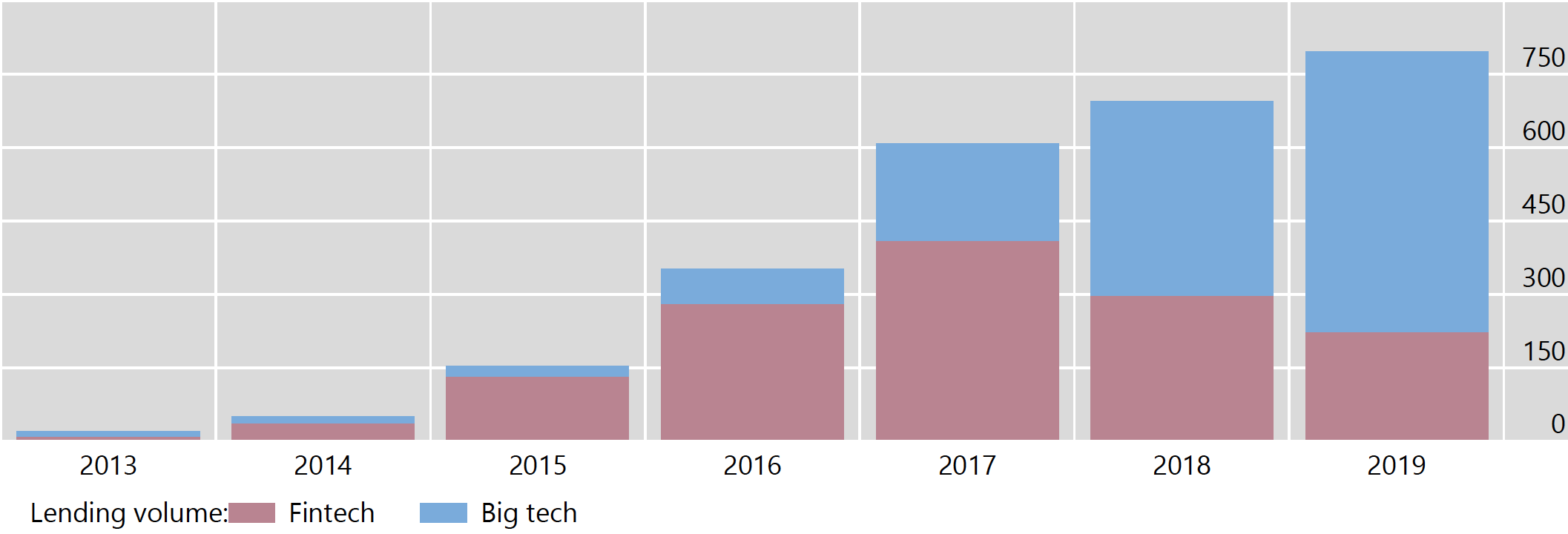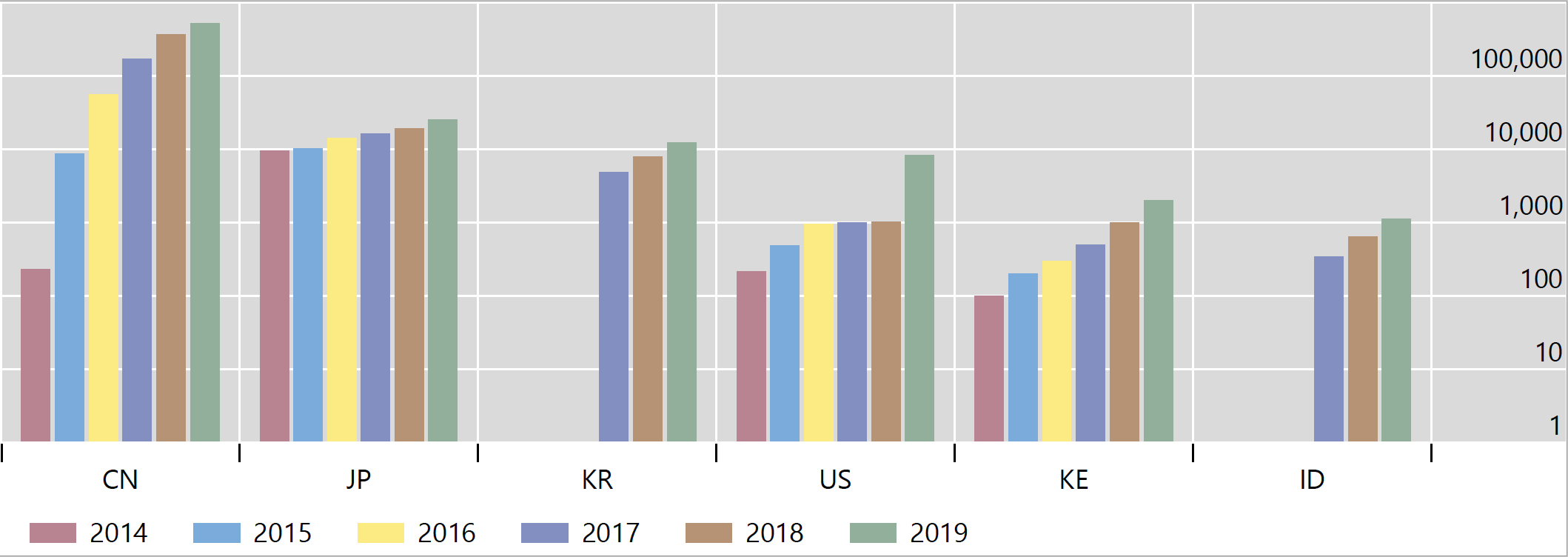In the last decade, two new types of credit intermediation have grown rapidly. Both use new technology to compete with banks in their core lending function (Stulz 2019).
The first innovation is fintech credit – i.e. credit activity facilitated by electronic (online) platforms that are not operated by commercial banks (Claessens et al. 2018). This is also called ‘debt-based alternative finance’ (Wardrop et al. 2015). It includes peer-to-peer or marketplace lending by platforms like Zopa and Funding Circle in the UK, Lending Club and SoFi in the US, Yiren Digital and others in China, and Harmoney in Australia and New Zealand. It also includes invoice trading, mini-bonds, and other forms of financing for consumers and small businesses based on online platforms. Data on this type of activity are compiled in the Cambridge Centre for Alternative Finance (CCAF) Global Alternative Finance database (Ziegler et al. 2020). These data, discussed in Rau (2020) and available from CCAF, are based on an annual online questionnaire of alternative finance volumes and characteristics available for the period 2013-2018.
A second innovation is the expansion of big tech firms into credit markets. Big tech refers to large companies whose primary activity is digital services, rather than financial services (de la Mano and Padilla 2018, Frost et al. 2019). These firms often have large established networks from non-financial business lines, such as electronic commerce (or e-commerce), social media or internet search, and these networks and activities give them access to valuable data on individuals and firms (BIS 2019). In recent years, many such firms have begun to lend to their users, either directly – for example, through a financial services subsidiary – or in partnership with traditional financial institutions. Examples include the lending activities of Alibaba’s Ant Group and Tencent’s WeBank in China, of Amazon in the US, UK, and other countries, of Google in India, of M-Pesa and other mobile money operators in Africa, or Grab and Go-Jek in Southeast Asia, and of Mercado Libre and others in Latin America.
Because these new forms of credit intermediation are new, they are often not yet included in official credit statistics. This is a problem, as central banks and regulators are responsible for monitoring credit markets. Like good pilots, authorities should not be ‘flying blind’.
We aim to fill this gap with a new paper (Cornelli et al. 2020) and database. The database combines data from the CCAF Global Alternative Finance database with hand-collected data on big tech credit from various public sources such as firms’ annual reports, as well as information from contacts at big tech companies and central banks.1
The data show that globally, big tech credit is booming and is overtaking fintech credit (Figure 1). Big tech lending volumes reached $572 billion in 2019 – a growth of 44% over 2018. Fintech credit volumes actually declined in 2019, by 25% to $223 billion. This decline is driven entirely by China, where regulatory reforms and a series of platform exits have led to a contraction in both the stock and flow of fintech lending. In other countries, fintech credit continues to grow rapidly.
Figure 1 Big tech credit is overtaking fintech credit (billions of US dollars)
Notes: 2019 fintech lending volume figures are estimated on AU, CN, EU, GB, NZ, and US.
Source: Cornelli et al. (2020).
The largest markets for big tech credit in absolute terms are China, Japan, Korea, and the US. In each of these markets, lending by big techs, either directly or in partnership with financial institutions, has risen rapidly (Figure 2). In Japan, e-commerce firm Rakuten and social media company LINE are notable lenders. In Korea, the two virtual banks Kakao Bank and KBank have ramped up their lending since their launch in 2017.
Figure 2 Big tech credit is booming in Asia, the US, and Africa (millions of US dollars, logarithmic scale)
Notes: Figures include estimates.
Source: Cornelli et al. (2020).
In some markets, the two new forms of credit intermediation are becoming economically relevant. In particular, the sum of fintech and big tech credit flows were equivalent to 2.0% of the stock of total private credit in China in 2019 (Figure 3). Meanwhile, they reached 5.8% of the stock of total credit in Kenya and 1.1% in Indonesia. In advanced economies, volumes are smaller relative to overall markets, but market shares can be large in specific market segments. In the UK, for example, Ziegler et al. (2020) estimate that fintech credit platforms accounted for up to 27.7% of equivalent bank credit to small and medium enterprises with annual turnover below £2 million in 2018. Buchak et al. (2018) and Fuster et al. (2018) show that fintech lenders are becoming important players in US mortgage markets.
Figure 3 Fintech and big tech credit are sizeable in some countries (millions of US dollars, logarithmic scale)
Notes: (1) Lending volume data is for 2019. (2) The ratio to total stock of credit refers to domestic credit provided by the financial sector. Data for 2018. (3) Total alternative credit is defined as the sum of fintech and big tech credit. Data for 2019.
Source: Cornelli et al. (2020).
Drivers of fintech and big tech credit
To understand the drivers of fintech and big tech credit, we perform panel regressions of log credit per capita for 79 countries over 2013-2018.2 We confirm that fintech and big tech credit can be explained by a mix of supply and demand factors.
On the demand side, we show the following:
- More developed economies (with higher GDP per capita) have a higher demand for credit from firms and households, and thus higher fintech and big tech credit. This relationship decreases for very high levels of development (in line with Claessens et al. 2018 and Bazarbash and Beaton 2020).
- When banking services are more expensive (higher banking sector mark-ups), for instance because of less competition, this may mean more demand for cheaper credit. Fintech credit is especially higher in these cases.
- Where there is a larger un(der)met demand for financial services, as proxied by fewer bank branches per capita, we find higher fintech credit volumes, but not more big tech credit.
On the supply side, we find that:
- More stringent banking regulation (a proxy for the overall stance of financial regulation; see Barba Navaretti et al. 2017) is associated with higher fintech and big tech credit. These rules may create barriers to the entry for fintech and big tech firms. Conversely, dedicated regulatory frameworks for fintech credit allow these markets to grow and develop (in line with Rau 2020).
- Institutional characteristics, such as the ease of doing business, investor protection, and disclosure and the judicial system, are associated with higher volumes, likely because they allow fintech and big tech firms to enter credit markets and to grow.
- Characteristics of the incumbent banking system and of financial markets shape innovation. Alternative credit volumes are higher where banks are better capitalised and where markets are deeper, implying that fintech and big tech credit can complement bank credit and market-based finance, rather than substituting for it.
Looking ahead: What implications for policy?
Fintech and big tech credit are growing rapidly in countries around the world. Data on their size and growth have until now been scarce. The CCAF database and the data in our new paper aim to fill this gap. Nonetheless, improving the data availability will remain an important policy priority. As such, efforts to include fintech and big tech credit providers in regulatory reporting should continue apace.
As with other forms of credit, there is the potential for these new forms of lending to enhance economic growth – but also to engender risks to the macroeconomy and financial system. In particular, as credit grows rapidly, there is the potential for individual borrowers to become over-indebted, and – as in past periods of rapid credit growth – even for risks to financial stability. Whether this growth represents the natural diffusion of a promising new type of intermediation or a credit bubble remains an open question; it may be possible to assess this only after a downturn.
In this light, the Covid-19 pandemic represents an important test to these new business models. Information on lending flows and credit losses over 2020 is not yet available. Yet it will be important to assess how new credit models function during their first downturn in the financial and business cycle. Yet after the initial shock and credit losses, it can be expected that the greater demand for online services may further support fintech and big tech credit. In some markets, fintech and big tech firms have even helped to channel emergency lending to small businesses. Policymakers should continue to monitor these new markets, develop a better understanding of their risks and potential. They may need to accelerate the pace of regulatory innovation to better regulate and supervise an increasingly digitalised financial sector (BIS 2020, World Bank and CCAF 2020).
Authors’ Note: The views expressed are those of the authors and do not necessarily represent those of the Bank for International Settlements.
References
Bank for International Settlements (BIS) (2019), “Big tech in finance: opportunities and risks”, BIS Annual Economic Report, Chapter III, June.
Bank for International Settlements (BIS) (2020), “Central banks and payments in the digital era”, BIS Annual Economic Report, Chapter III, June.
Barba Navaretti, G, G Calzolari, J M Mansilla-Fernandez and A F Pozzolo (2017), “FinTech and Banks: Friends or Foes?”, European Economy: Banks, Regulation, and the Real Sector, 2 December.
Bazarbash, M and K Beaton (2020), “Filling the Gap: Digital Credit and Financial Inclusion”, IMF Working Paper 20/150.
Buchak, G, G Matvos, T Piskorski and A Seru (2018), “Fintech, regulatory arbitrage, and the rise of shadow banks”, Journal of Financial Economics 130(3): 453–83.
Claessens, S, J Frost, G Turner, and F Zhu (2018), “Fintech credit markets around the world: size, drivers and policy issues”, BIS Quarterly Review, September.
Cornelli, G, J Frost, L Gambacorta, R Rau, R Wardrop and T Ziegler (2020), "Fintech and big tech credit: a new database", BIS Working Paper 887 (also published as CEPR Discussion Paper 15357).
Frost, J, L Gambacorta, Y Huang, H S Shin and P Zbinden (2019), “BigTech and the changing structure of financial intermediation”, Economic Policy 34(100): 761–99.
Fuster, A, M Plosser, P Schnabel and J Vickery (2018), “The role of technology in mortgage lending”, Federal Reserve Bank of New York Staff Reports, no 836, February.
Mano, M de la and J Padilla (2018), “Big tech banking”, Journal of Competition Law & Economics 14(4): 494–526.
Rau, R (2020), “Law, trust, and the development of crowdfunding”, University of Cambridge Working Paper.
Stulz, R (2019), “FinTech, BigTech, and the Future of Banks”, Journal of Applied Corporate Finance 31(4): 86–97.
Wardrop, R, B Zhang, R Rau and M Gray (2015), “Moving mainstream: the European alternative finance benchmarking report”, Cambridge Centre for Alternative Finance.
World Bank and Cambridge Centre for Alternative Finance (2020), “The Global Covid-19 FinTech Regulatory Rapid Assessment Report”, World Bank Group and the University of Cambridge, October.
Ziegler, T, R Shneor, K Wenzlaff, B Wang, J Kim, A Odorovic, F Ferri de Camargo Paes, K Suresh, B Zhang, D Johanson, C Lopez, L Mammadova, N Adams and D Luo (2020), The Global Alternative Finance Market Benchmarking Report, April.
Endnotes
1 In some cases, it has been necessary to estimate lending flows based on end-year stocks of credit, and to estimate 2019 numbers based on figures in past years and growth in user numbers or revenues. Where big tech firms lend in multiple jurisdictions, it has sometimes been necessary to make assumptions about how such lending is distributed across different markets.
2 We exclude 2019 volumes given the lack of availability of many independent variables.












